Battery Packaging Market Outlook - 2031
The global battery packaging market size was valued at $24.5 billion in 2021, and is projected to reach $61.5 billion by 2031, growing at a CAGR of 9.7% from 2022 to 2031. The surge in electric vehicle (EV) adoption globally, driven by rising environmental concerns and government incentives, is significantly boosting the demand for lithium-ion batteries, which are the preferred energy storage solution for EVs due to their high energy density and long lifespan.
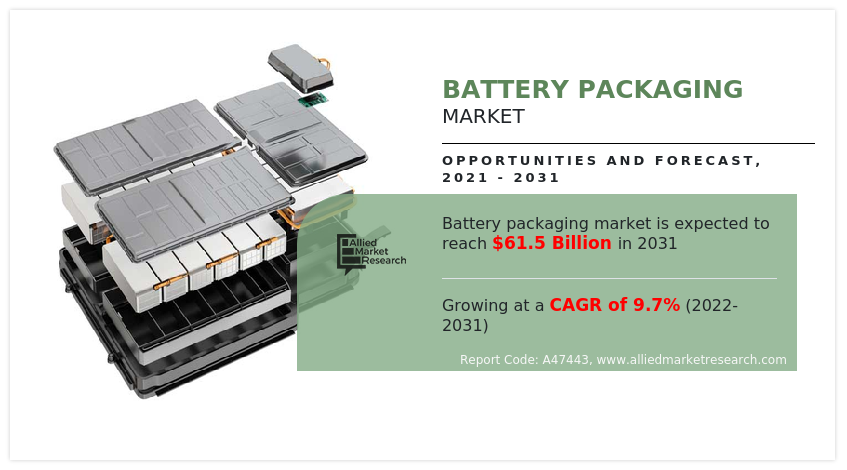
Introduction
Battery packaging is the process of safeguarding batteries such as lithium-ion, lead acid, flow battery, and others for protection purposes. In addition, cell packaging designs and their combinations in modules and battery packs are offered in a vast variety, for primary and secondary batteries. Packaging of batteries reduces any leakage of chemical substances and protects from unexpected wear and tear. Battery packaging has a wide range of applications in automotive, industrial, electronics, and others.
Report key highlighters:
- The report outlines the current battery packaging market trends and future scenario of the market from 2022 to 2031 to understand the prevailing opportunities and potential investment pockets.
- The global battery packaging market has been analyzed in terms of value ($Million) and volume (Kilotons). The analysis in the report is provided on the basis of material type, battery type, casing type, 4 major regions, and more than 15 countries.
- The battery packaging market is consolidated in nature with few players such as Deutsche Post AG, EPEC LLC, NEFAB Group, Wellplast AB, schott, Sohner Kunststofftechnik GmbH, DS Smith Plc, heitkamp & thumann group, targray, and zarges gmbh, which hold significant share of the market.
- The report proivdes strategy planning and industry dynamics to enhance decision making for existing market players and new entrants entering the battery packaging industry.
- Countries such as China, U.S., India, Germany, and Brazil hold a significant share in the global battery packaging market.
Market Dynamics
Lithium-ion batteries are widely used in various applications, including electric vehicles (EVs), consumer electronics, renewable energy storage, and industrial machinery, due to their high energy density, long life cycle, and compact size. As the global transition toward sustainable energy solutions intensifies, the production of lithium-ion batteries has skyrocketed, particularly in the electric vehicle sector. With governments around the world promoting policies to phase out internal combustion engine vehicles and invest in EV infrastructure, the surge in EV adoption is directly fueling the demand for high-performance lithium-ion batteries, thereby necessitating specialized packaging solutions that ensure their safety, efficiency, and durability. All these factors are expected to drive the demand for the battery packaging market during the forecast period.
Moreover, the installation of solar battery can effectively reduce carbon footprints. Implementation of battery packaging can make a nation energy independent and reduce the dependence on imported fossil energy resources. Furthermore, growing interest of industry players toward renewable energy storage solutions is expected to increase investment opportunities during the forecast timeframe. For instance, countries, such as the UK and Portugal, are encouraging capacity auctions for solar battery storage instead of conventional energy storage systems.
However, lithium-ion batteries are sensitive to elevated temperature due to which they have a short life cycle. This is projected to affect the growth of the battery packaging market. In addition, low efficiency and excessive cost of sustainable technologies are expected to hamper market growth.
As renewable energy sources such as solar and wind power are becoming more widespread, there is a growing need to store this energy for use during periods of low generation or high demand. This has led to the development and deployment of energy storage systems, which rely heavily on advanced batteries to store electricity efficiently. The growth of these systems creates a corresponding demand for specialized battery packaging that ensures safety, longevity, and optimal performance of the batteries. Battery packaging for energy storage systems must meet strict requirements for thermal management, mechanical stability, and protection from environmental factors. Efficient thermal management is critical to maintaining battery life and performance, particularly in large-scale storage systems where batteries generate significant heat. All these factors are anticipated to offer new growth opportunities for the global battery packaging market throughout the forecast period.
Market Segmentation
The battery packaging market is segmented into material type, battery type, casing type, and region. On the basis of material type, the market is divided into all metals, plastics, and others. On the basis of battery type, the market is categorized into lithium ion, lead acid, nickel cadmium, and others. On the basis of casing type, it is classified into cylindrical, prismatic, coin, and others. Region-wise, the market is studied across North America, Europe, Asia-Pacific, and LAMEA.
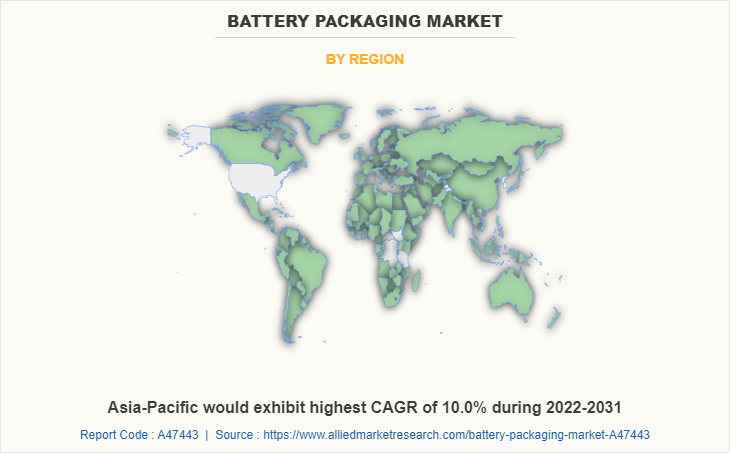
Battery Packaging Market By Region
The Asia-Pacific region is projected to grow at the highest CAGR of 10.0% during the forecast period and account for 63% of battery packaging market share in 2021. Asia-Pacific dominates the market with more than 40% revenue share. This is attributed to rise in concern from governments across emerging nations, such as China, India, and South Korea, regarding zero-emission norms. Moreover, China is the topmost producer of electric vehicles in the world where lithium-ion energy storage barriers are widely employed in electric vehicles, which propel the battery packaging market growth.
Moreover, China being the largest producer of solar power is expected to further foster the growth of the market in Asia-Pacific. Furthermore, the presence of leading battery manufacturers such as GS Yuasa, Panasonic, Exide, LG, and others are likely to boost the market. Moreover, Europe has accounted for the second highest revenue-generating region for the global battery packaging market and is projected to grow at 9.5% CAGR during the forecast period.
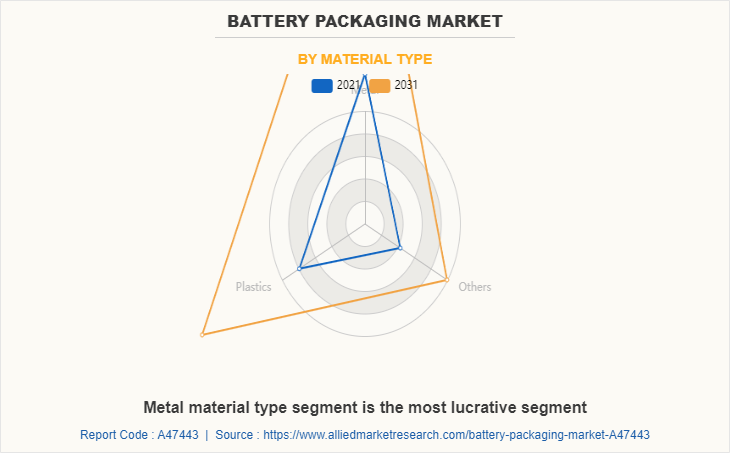
Battery Packaging Market By Material Type
In 2021, the metal was the largest revenue generator and is anticipated to grow at a CAGR of 9.9% during the forecast period. Increase in the production rate of crude steel is anticipated to enhance the metal manufacturing industry. For instance, according to an article published by the India Brand Equity Foundation in December 2022, India’s crude steel production stood at 71.3 MT (Metric Ton) in FY23 (until October 2022). This factor enhances the overall production of metal during the forecast period.
Furthermore, several manufacturers have increased their production capacities for metal due to the substantial increase in the demand for metal in battery packaging. Aluminum, nickel, and iron are good conductors of electricity owing to which it is extensively used in battery packaging as a covering and protecting material. Moreover, the plastic material type segment accounted for the second largest revenue-generating segment. In recent times polymers, such as polypropylene, have replaced aluminum as the material of choice for casings due to the easy moldability of polymers into various shapes along with excellent chemical resistance. This factor has enhanced market growth. Moreover, polyvinyl chloride PVC coverings are the most widely adopted resin across the globe.
According to an article published by The European Council of Vinyl Manufacturers in 2021, polyvinyl chloride (PVC) is one of the most used plastics in the world. Global use of polyvinyl chloride exceeds 40 billion tons per year. This factor has increased the overall production capacities for PVC-based battery packaging sheets from various end-use industries such as building and construction, medical, automobile, packaging, and others; thus, offering the most lucrative opportunities for the market.
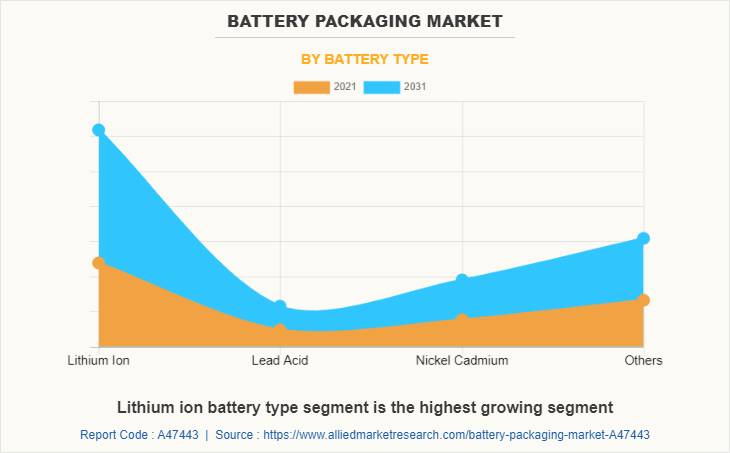
Battery Packaging Market By Battery Type
By battery type, the lithium ion segment dominated the global market in 2021, and is anticipated to grow at a CAGR of 10.1% during forecast period. Prismatic cell and metal-based material is used for lithium-ion battery packaging which has enhanced the overall demand for lithium ion batteries in the market. Furthermore, utilization of lithium-ion batteries have increased in the electrical sector owing to the rise in industrialization, urbanization, and growing consumer demand for various electric-based devices, vehicles and growing prominence of sustainable energy solutions is expected to surge the demand for lithium-ion battery; thus, helps in increase the potential sales for the market.
In response to this, the nickel-cadmium battery type segment is growing at 9.3% CAGR during the forecast period. Nickel-cadmium batteries are widely utilized in electronic components as an electrode. Nickel-cadmium battery offers higher power density owing to which metal type of cell packaging has a huge scope in the electronics industry.
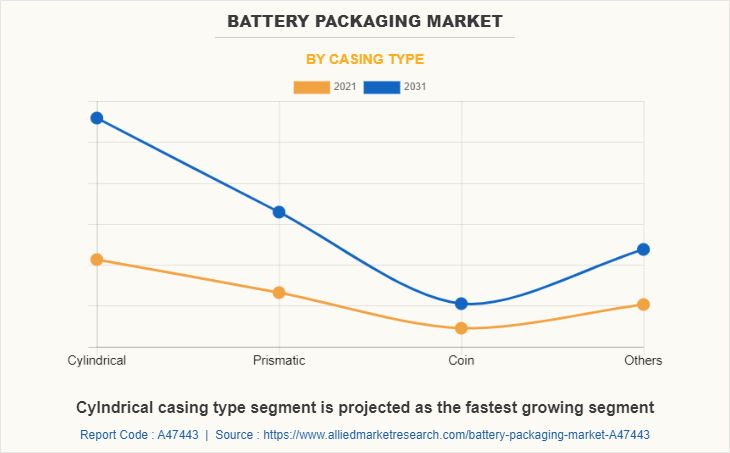
Battery Packaging Market By Casing Type
By casing type, the cylindrical casing type segment dominated the global market in 2021, and is anticipated to grow at a CAGR of 10.2% during forecast period. The cylindrical cell continues to be one of the most widely used packaging styles for primary and secondary batteries. Cylindrical casing types possess some advantages such as ease of manufacture and good mechanical stability.
The tubular cylinder can withstand high internal pressures without deforming owing to which it is extensively used in various end use industry such as, power tools, medical instruments, laptops, and electric vehicles. This factor is projected to escalate the demand for battery packaging market for cylindrical casing segment. The prismatic casing type segment is the second largest revenue gernating segment and accounted for 27% of the total market share in 2021. The prismatic-based casing is used in solar energy storage systems. Its larger size makes it best suited for solar energy-intensive applications. This may act as one of the key drivers responsible for the growth of the prismatic battery packaging market.
Key Market Trends:
Several key manufacturers are actively engaged in offering sustainable battery production. For instance, Drax company offers battery recyclability. This recycling procedure offers safe extraction of raw materials for use in other end use industries and products. This key market trend is projected to offer most remunerative opportunities for the battery packaging market.
Competitive Landscape
The global battery packaging market profiles leading players that include Deutsche Post AG, EPEC LLC, NEFAB Group, Wellplast AB, schott, Sohner Kunststofftechnik GmbH, DS Smith Plc, heitkamp & thumann group, targray, and zarges gmbh. The global battery packaging market report provides in-depth competitive analysis as well as profiles of these major players.
Key Recent Developments:
In April 2022, Deutsche Post DHL Group, launched its commercial customers new on-demand packaging solutions to make shipments more cost-effective and environmentally friendly. Ths strategic product launch is projected to increase the potentail sales of compnay's battery pakcgaing solutions.
In June 2021, ZARGES company launched a new product named as ZARGES K 470 battery box. This new product offers protection to the hazardous goods by packaging items. This strategic product launch is expected to enhance ZARGES's product portfolio.
Key Benefits For Stakeholders
- The market research is offered along with information related to key drivers, restraints, and opportunities.
- Porter's five forces analysis highlights the potency of buyers and suppliers to enable stakeholders make profit-oriented business decisions and strengthen their supplier-buyer network.
- In-depth analysis of the battery packaging market segmentation assists to determine the prevailing market opportunities.
- Market player positioning facilitates benchmarking and provides a clear understanding of the present position of the market players.
- The report includes the analysis of the regional as well as global battery packaging market trends, key players, market segments, application areas, and market growth strategies.
Battery Packaging Market Report Highlights
| Aspects | Details |
| Market Size By 2031 | USD 61.5 billion |
| Growth Rate | CAGR of 9.7% |
| Forecast period | 2021 - 2031 |
| Report Pages | 509 |
| By Material Type |
|
| By Battery Type |
|
| By Casing type |
|
| By Region |
|
| Key Market Players | zarges gmbh, Wellplast AB, NEFAB Group, targray, schott, Deutsche Post AG, DS Smith Plc, Sohner Kunststofftechnik GmbH, heitkamp & thumann group, EPEC LLC |
Analyst Review
According to CXOs of leading companies, the battery packaging market is expected to witness considerable growth. This is attributed to a significant surge in the demand from residential and commercial end-users. Distinct types of batteries such as lithium ion, lead acid, vanadium, and others are extensively used in hospitals, hotels, schools, educational institutions, and restaurants for energy storage and utility purposes.
In addition, rise in concern from governments across emerging nations, such as China, India, and South Korea, regarding zero emission norms is expected to drive the market growth. Governments across different countries implement new rebate and energy schemes on excess energy for residential and commercial users. This is expected to enhance the battery packaging market penetration in new customer segments.
The CXOs further added that sustained economic growth and the development of the residential & commercial and battery manufacturing sectors have surged the popularity of battery packaging market.
The battery packaging market valued for $24.5 billion in 2021 and is estimated to reach $61.5 billion by 2031, exhibiting a CAGR of 9.7% from 2022 to 2031.
Latest trend such as several key manufacturers are actively engaged in offering sustainable battery production. For instance, Drax company offers battery recyclability. In addition, the company’s recycling procedure offers safe extraction of raw materials for use in other industries and products, the majority of discarded batteries are left to rot in landfill sites. This key market trend is projected to offer most remunerative opportunities for the battery packaging market.
Battery packaging is the process of safeguarding batteries such as lithium-ion, lead acid, flow battery, and others for protection purposes. In addition, cell packaging designs and their combinations in modules and battery packs are offered in a vast variety, for primary and secondary batteries. Packaging of batteries reduces any leakage of chemical substances and protects from unexpected wear and tear. Battery packaging has a wide range of applications in automotive, industrial, electronics, battery packaging battery, and others.
The battery packaging market is segmented into material type, battery type, casing type, and region. On the basis of material type, the market is divided into all metals, plastics, and others. On the basis of battery type, the market is categorized into lithium ion, lead acid, nickel cadmium, and others. On the basis of casing type, it is classified into cylindrical, prismatic, coin, and others. Region-wise, the market is studied across North America, Europe, Asia-Pacific, and LAMEA
Deutsche Post AG, EPEC LLC, NEFAB Group, Wellplast AB, schott, Sohner Kunststofftechnik GmbH, DS Smith Plc, heitkamp & thumann group, targray, and zarges gmbh.
Renewable energy sector is the leading application segment of battery packaging market.
Asia-Pacific is the largest regional market for battery packaging.
Loading Table Of Content...



